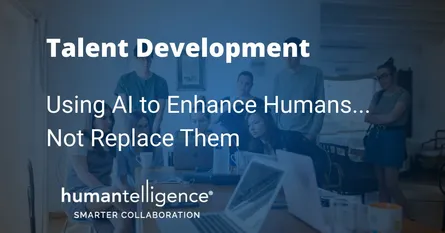
Ai

AI to Enhance Humans...Not Replace Them at Work
- 17 Oct, 2024
- AI
Emotional intelligence at work has become a cornerstone for effective professional interactions in modern society. As workplaces become more complex and diverse, the ability to understand and manage emotions—both one’s own and those of others—has become essential for fostering productive and integrated work environments. The World Economic Forum's "Future of Jobs Survey" highlights that by 2025, emotional intelligence will be one of the top skills required in business, highlighting its growing importance in the professional sphere. Despite its recognized value, developing and applying emotional intelligence at work present numerous challenges. Traditional training methods, which are often costly and difficult to scale, fail to provide the practical, real-time application necessary for true skill acquisition. Of the employees who received traditional training, 43% considered it ineffective. Furthermore, identifying and recruiting talent with high emotional intelligence is a complex process, often relying on subjective measures and lengthy evaluation periods. Enter artificial intelligence (AI). By leveraging AI technologies, organizations can improve emotional intelligence in the workplace and overcome potential hurdles by offering scalable, personalized, and effective solutions. How Can AI Help Individuals Develop Emotional Intelligence? AI technologies can play a pivotal role in overcoming the challenges associated with developing and applying emotional intelligence in the workplace. At Humantelligence, I've seen firsthand how AI-powered assessments can scan entire companies and enhance collaboration. By analyzing communication patterns in meetings and written interactions (both offline and virtual), these tools provide real-time, personalized feedback on how to improve emotional interactions. Employees then receive insights on how to adapt their communication to better suit their audience's preferences and motivations, ensuring more effective and empathetic exchanges. In our own workplace, we use AI tools to rewrite communication at the push of a button, tailoring messages to the emotional preferences of the recipients. This feature enhances day-to-day interactions and fosters a more emotionally intelligent workplace culture. In meetings, our AI engine scans the dynamics and provides the emotional intelligence insights needed to improve productivity and collaboration. This proactive approach integrates emotional intelligence into everyday workflows, rather than letting it be a neglected aspect of professional development. We also address the challenge of scalability in emotional intelligence training. While traditional training methods are often focused on a small percentage of leaders and managers, all employees receive personalized training up to 20 times a month, equating to 240 interactions a year. This consistent use makes the training more impactful and transformational across the organization. During recruitment, we utilize advanced psychometric evaluations and behavioral analysis to assess candidates' emotional competencies. This approach allows us to identify high emotional intelligence candidates early in the hiring process, leading to better team dynamics and performance. 3 Best Practices to Integrate AI with Emotional Intelligence Training for Improved Professional Interactions Integrating AI with emotional intelligence training can significantly enhance professional interactions and workplace dynamics. The following are just a few of the best practices we've learned while integrating AI across our organization and navigating the challenges that arose along the way. 1. Look for Personalized Learning Opportunities Seventy-five percent of Fortune 500 companies use emotional intelligence training, and for good reason. These AI tools can analyze individual learning styles and preferences to deliver tailored training programs that meet the specific needs of each employee. At Humantelligence, we've seen how AI tools can adapt training content with a click of a button to meet the needs of each user. For example, if an employee struggles with a particular aspect of emotional intelligence, AI can provide additional resources and exercises to address that specific area. An effective AI-driven platform should provide personalized insights and training modules that help employees develop their emotional intelligence skills in a way that is most effective for them. This approach ensures that employees are more engaged and can apply what they learn sooner rather than later. 2. Implement Real-Time Feedback Mechanisms Real-time feedback is crucial for the practical application of emotional intelligence skills. AI technologies can provide immediate insights and suggestions based on an employee's interactions and communications. In fact, Gallup data show that when employees receive meaningful feedback within the last week, they’re almost four times more likely to be engaged. To meet this need at Humantelligence, we implemented a tool that offers real-time feedback on email communications and meeting dynamics. These real-time insights are surfaced within an employee’s workflow, which helps them adjust their behavior and improve their emotional intelligence in the moment. This continuous feedback loop is essential for reinforcing learning and promoting ongoing development. 3. Integrate Emotional Intelligence Training into Daily Workflows Emotional intelligence training should be seamlessly integrated into the daily workflows of your employees. In our daily workflows, we use AI tools that can be embedded into existing work processes, such as communication platforms and meeting tools. This integration makes it easier for employees to access and apply their training in real-world scenarios. For those who struggle with soft skills, AI-driven training insights can also be an essential resource for enhanced productivity and job satisfaction. According to research from IDC, organizations stand to benefit up to $1 trillion in productivity gains worldwide over the next two years by implementing skills development powered by generative AI and automation. AI can significantly improve collaboration among teams by providing real-time insights into their communications, helping them work better and faster together. This ensures that emotional intelligence training is not an isolated event but a continuous part of their everyday interactions. As emotional intelligence becomes increasingly important in the workplace, leveraging AI to provide scalable, personalized, and real-time training can address many of the challenges associated with traditional emotional intelligence development methods. By adopting best practices for integrating AI and emotional intelligence, organizations can foster a more emotionally intelligent workforce, leading to better communication, stronger teamwork, and improved overall performance.